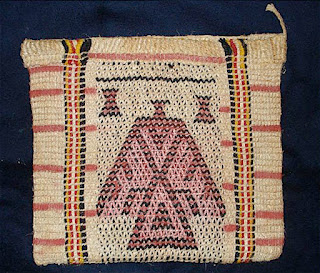The techniques used in making these bags are the same as those used to produce the textiles found in pottery impressions from the Middle Mississippian culture, AD 600 - 1600. Some scholars believe that these techniques may have been in use before 5000 BC. Originally produced using plant fibers and animal hair, these types of textiles are mentioned by writers with DeSoto in the mid 1500's and du Pratz in the mid 1700's. Marquette and Hennipin mention various fabricated articles among the tribes they visited in the late 1600's. Both the "plain" utilitarian bags for hulling and washing corn and for storage, and the bags with figures of animals and spirit beings or geometric patterns worked into them, have been collected in significant numbers from the Great Lakes tribes and their nearby prairie neighbors. Although the collections are predominantly of articles from the latter half of the 19th century, some scholars place the figured bags as early as the mid-18th century. These open-twined bags were made mostly of plant fibers and animal hair but European cordages and wool yarns begin to show up by the mid 1700's. At about the same time another type bag begins to appear where the figures are even more stylized than on the open-twined bags. These bags are done in a compact-twining technique, where the wefts have no spacing between them and the patterns are created with the weft rather than the warp strands. The bags appear to always be woven upside down. Starting at the bottom and working down to the top, finishing with the opening edge of the bag. The most common method is by hanging the warps over a stick and then twining around and around to make a seamless bag. The figures are worked upside down so that when the bag is finished they will appear right side up.
These bags range in size from 3 or 4 inches up to over 2 feet wide. Regardless of size it appears that, unlike the fingerwoven bags made of yarn with beaded designs, none of these bags were made with straps for carrying on one's person. The bags with figures from the natural and spirit worlds are usually different on each side, in keeping with the beliefs of upper and lower levels of the world ruled by different spirits, with the earth in the middle.
Copy and photos supplied by Tom Conde at Conde Trading





























No comments:
Post a Comment
Note: Only a member of this blog may post a comment.